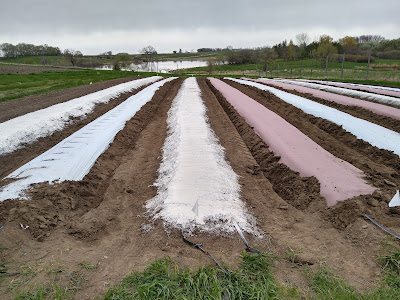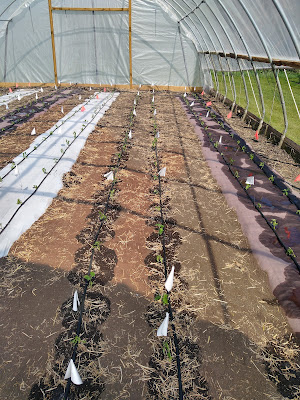Author: Nate Dalman, Research Professional 3, West Central Research and Outreach Center, Morris, MN.
Weed control is a major concern for all farmers and gardeners regardless of field size. Many growers rely on plastic mulch due to its effectiveness, and because it can help conserve soil moisture and increase soil temperature. However plastic mulch must be discarded at the end of the season resulting in a large amount of plastic waste. Fortunately, new products are being developed to achieve the same benefits of as plastic mulch but are biodegradable and can be incorporated into the soil rather than ending up in a landfill.
In 2021, at the West Central Research and Outreach Center in Morris, MN, two experiments took place to test some of these new mulch products against plastic. One involved growing day neutral strawberries in a white on black plastic mulch, paper mulch, and a product called BioMulch. The paper mulch used was WeedGuard Plus® creped version which allows for greater flexibility and less tearing during installation compared to non-creped paper mulches. BioMulch is a spray-on mulch being developed by the Agriculture Utilization Research Institute and is composed of agricultural residue products. The goal of this projects was to determine weed control effectiveness and yield effects. The other project involved bell peppers, and the same plastic and paper mulches were used. A third treatment of no mulch was also studied. We measured yield effects as well as weed control.
Weed control is a major concern for all farmers and gardeners regardless of field size. Many growers rely on plastic mulch due to its effectiveness, and because it can help conserve soil moisture and increase soil temperature. However plastic mulch must be discarded at the end of the season resulting in a large amount of plastic waste. Fortunately, new products are being developed to achieve the same benefits of as plastic mulch but are biodegradable and can be incorporated into the soil rather than ending up in a landfill.
In 2021, at the West Central Research and Outreach Center in Morris, MN, two experiments took place to test some of these new mulch products against plastic. One involved growing day neutral strawberries in a white on black plastic mulch, paper mulch, and a product called BioMulch. The paper mulch used was WeedGuard Plus® creped version which allows for greater flexibility and less tearing during installation compared to non-creped paper mulches. BioMulch is a spray-on mulch being developed by the Agriculture Utilization Research Institute and is composed of agricultural residue products. The goal of this projects was to determine weed control effectiveness and yield effects. The other project involved bell peppers, and the same plastic and paper mulches were used. A third treatment of no mulch was also studied. We measured yield effects as well as weed control.
Strawberry trial
In the strawberry experiment, all mulches were installed at the same time in early May and left in place until late October. Plants were transplanted several days after mulch installation. Weed control effectiveness was determined by measuring the percentage of an area covered by weeds and this was done three times throughout the growing season. Each time, the paper and plastic mulches had effective weed control while the BioMulch was less effective. Averages over the whole season show that plastic allowed for only about 2% weed coverage, paper about 4%, and BioMulch about 17% weed coverage of an area. In terms of yield, the highest yielding mulch type varied over the course of the season with each mulch type leading yielding the best for part of the season. When looking at the total yield produced over the whole season, there was no significant difference between mulch types suggesting that mulch type doesn’t influence yields. At the end of the season, plastic mulch was removed and disposed of and the paper mulch and BioMulch were easily incorporated into the soil.BioMulch in center with paper mulch on the right and plastic on the left
Pepper trial
The pepper experiment took place in a high tunnel and weed suppression was not measured due to very low weed pressure in the tunnel. Again, all treatments were installed in early May and were in place until October. The effect on yield was very prominent between the plastic, paper, and no mulch treatments. Plastic mulch yielded the highest, followed by no mulch, and paper mulch had the lowest yields. This was interesting as plants in all treatments appeared to have similar vigor.Plastic mulch on left, no mulch in center and paper mulch on right.
In conclusion, it was evident that paper mulch has the potential to control weeds as effectively as plastic does. BioMulch is able to suppress weeds to an extent but not as well. With the mulch types having no effect on strawberry yields but a distinct effect on pepper yields, this suggests that certain crops might be more sensitive to mulch types than others. Further research will help us determine if that is the case or not and we expect to continue to explore alternative weed control methods to plastic.
Tips for using paper mulch
Many growers do not use paper mulch, because it has a reputation for tearing or blowing away. Over the years, we’ve had varying success with paper mulch, and come up with the following strategies for using it more effectively.- Creped paper mulch is better suited to mulch laying equipment than the standard flat types.
- Carefully inspect the sides to make sure edges are thoroughly covered with soil to prevent wind from catching and tearing the paper.
- We do not recommend using stakes or staples as the small holes they make seem to decrease the strength of the paper and allow for more water and wind damage.
- If in a high wind area, blocks or rocks can be placed on top of the paper every 8-10’ to keep the paper low to ground and not catching wind.
- Once the crop is large enough, it helps keep the paper in place and not blowing away.


Comments
Post a Comment